Inspirations ...
Grass Routes draws inspiration from the everyday extraordinary people we meet, the enduring natural landscapes we encounter and the thriving traditional cultures that have enriched our lives. Listed below are just some of the wonderful people you’re likely to meet on a Grass Routes journey.
People - Meet the Locals
One of the best things about traveling is making connections with people in meaningful and mutually enjoyable ways. Grass Routes provides a bridge for people of diverse cultures and beliefs to unite, interact and share experiences. Whether it’s learning how to steer a bullock cart or dancing the night away with tribal communities, our travelers experience local life from a grassroots perspective, up close and personal!
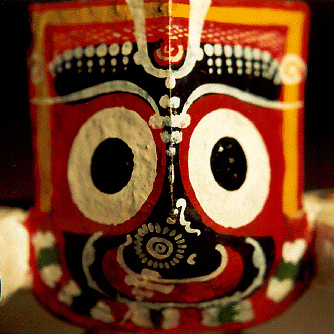 Jagannath The prevailing culture in Odisha revolves around Hindu God, Lord Jagannath. The only place in India where he is worshiped, the culture surrounding Lord Jagannath is exceptionally unique. Revered as ‘Lord of the Universe’ his exact origins are disputed. The culture is a synthesis of ancient Hindu beliefs and tribal rituals. Lord Jagannath is worshiped as a human being; his servitors brush his teeth, bathe him, change his clothes, adorn him with jewellery and offer 56 varieties of food! Jagannath The prevailing culture in Odisha revolves around Hindu God, Lord Jagannath. The only place in India where he is worshiped, the culture surrounding Lord Jagannath is exceptionally unique. Revered as ‘Lord of the Universe’ his exact origins are disputed. The culture is a synthesis of ancient Hindu beliefs and tribal rituals. Lord Jagannath is worshiped as a human being; his servitors brush his teeth, bathe him, change his clothes, adorn him with jewellery and offer 56 varieties of food!
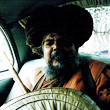 Mahima There is much to distinguish the Mahima’s from the saffron clad holy men found throughout India. Under the palm leaf umbrella, dreadlocked hair and ash smeared forehead is a sincere seeker of truth. Mahima's do not entertain casteism, idolatry or belief in spirits, choosing simply One God. Practicing non-violence and non-attachment they move alone, accept alms and sleep under an open sky. Drawing from both Hinduism and Buddhism, Mahimaism is essentially a humanist cult creating a synthesis between spiritual and temporal life. Mahima There is much to distinguish the Mahima’s from the saffron clad holy men found throughout India. Under the palm leaf umbrella, dreadlocked hair and ash smeared forehead is a sincere seeker of truth. Mahima's do not entertain casteism, idolatry or belief in spirits, choosing simply One God. Practicing non-violence and non-attachment they move alone, accept alms and sleep under an open sky. Drawing from both Hinduism and Buddhism, Mahimaism is essentially a humanist cult creating a synthesis between spiritual and temporal life.
Tribes of Odisha
Adivasis literally "original inhabitants" are the indigenous population of India. Nestled in the hills of the Eastern Ghats they constitute 25% of Odisha's population; the most populous Adivasi region of all India. They comprise 62 diverse ethnicities and although co-dependent, fiercely guard their own distinct traditions. We will meet various tribes and witness a way of life relatively unchanged throughout centuries.
Kondh Once infamous for their human sacrifice during British colonialism in India, the Kondhs are believed to be from Proto-Australoid racial stock. They have a distinct language called "Kui" which has no written script. They are plain land dwellers adapting best to the forest environment. 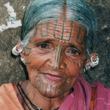
Kutia Kondh The docile Kutia Kondh are a peace loving people with a strong belief in the spirit world. Their medicine man ‘Jani’ conducts rituals during time of sickness and death to ward off evil omens and the dreaded tiger. The women are readily identifiable by their geometric facial tattoos that on close observation bear striking similarity to tiger's whiskers. These identifying marks ensure they will recognize each other in the spirit world.
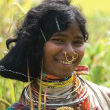 Dongria Kondh The most ancient Kondh sub group, the uncompromising Dongria Kondh inhabit the Niyamgiri hills subsisting on shifting cultivation supplemented by foraging, hunting & gathering. Dongria men and women are equally striking with their long well-oiled hair tucked into traditional combs, but that’s where their similarities end. Women are key to Dongria society, contributing far beyond her male counterpart in cultivation, cooking, harvesting and marketing produce. Consequently the Dongria woman affords a steep bride price regardless of whether the marriage is by mutual consent, negotiation or capture. Dongria society provides an appropriate platform (literally ‘dormitory’) for adolescent boys and girls to meet and find the right partner. Their dormitory system forms part of their enculturation and education process teaching them social taboos, myths, stories and riddles while singing and dancing through the night. Dongria Kondh The most ancient Kondh sub group, the uncompromising Dongria Kondh inhabit the Niyamgiri hills subsisting on shifting cultivation supplemented by foraging, hunting & gathering. Dongria men and women are equally striking with their long well-oiled hair tucked into traditional combs, but that’s where their similarities end. Women are key to Dongria society, contributing far beyond her male counterpart in cultivation, cooking, harvesting and marketing produce. Consequently the Dongria woman affords a steep bride price regardless of whether the marriage is by mutual consent, negotiation or capture. Dongria society provides an appropriate platform (literally ‘dormitory’) for adolescent boys and girls to meet and find the right partner. Their dormitory system forms part of their enculturation and education process teaching them social taboos, myths, stories and riddles while singing and dancing through the night.
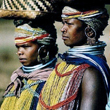 Bonda Fiercely independent and aggressive, Bondas are one of the most ancient tribes of India. Living in isolated high hill forests they continue to practice shifting cultivation and maintain a barter system. Bonda women are distinguished more for their masculinity than femininity and as much by their nudity (their clothing consists simply of a tiny skirt) as by their countless colorful beads looped around their head and neck. Interestingly they prefer to marry younger men in the hope they will have someone to care for them in their old age. Their language is ‘Remo’, an Austro-Asiatic language belonging to the Mundari group. Bonda Fiercely independent and aggressive, Bondas are one of the most ancient tribes of India. Living in isolated high hill forests they continue to practice shifting cultivation and maintain a barter system. Bonda women are distinguished more for their masculinity than femininity and as much by their nudity (their clothing consists simply of a tiny skirt) as by their countless colorful beads looped around their head and neck. Interestingly they prefer to marry younger men in the hope they will have someone to care for them in their old age. Their language is ‘Remo’, an Austro-Asiatic language belonging to the Mundari group.
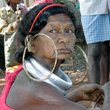 Gaddava One of India’s ancient ethnicities, the Gaddava are a ritualistic society. Fond of music and famed for their traditional ‘dhemsa’ dance, the Gaddavas need little excuse to celebrate. Their men and women are considered equal in every respect. Gaddava women are traditionally distinguished by their facial tattoos and heavy neck rings that can only be removed by a blacksmith. Their kinship system plays a vital role in daily life with every family appointed a ‘god brother’ providing a second line of defense in moments of crisis. Gaddava One of India’s ancient ethnicities, the Gaddava are a ritualistic society. Fond of music and famed for their traditional ‘dhemsa’ dance, the Gaddavas need little excuse to celebrate. Their men and women are considered equal in every respect. Gaddava women are traditionally distinguished by their facial tattoos and heavy neck rings that can only be removed by a blacksmith. Their kinship system plays a vital role in daily life with every family appointed a ‘god brother’ providing a second line of defense in moments of crisis.
Gaddavas depend on agriculture supplemented by collection of forest produce, hunting and fishing. Although they domesticate local varieties of cow and buffalo, the Gaddava do not milk them in the belief it reduces their strength. Their language 'Gutab' belongs to the Munda linguistic family.
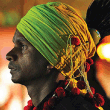 Gond The Gonds, with over four million people are the largest tribe in Central India. Gondwana or "land of the Gonds" gave its name to Gondwanaland, the ancient southern supercontinent comprised of present-day Africa, Madagascar, South America, Australia, the Indian subcontinent and Antarctica. Traditionally agriculturalists; some Gonds practice shifting cultivation, while others raise cereals or herd cattle. Together with Santhals and Bhils, the Gonds have traditionally dominated the regions in which they have lived. Gond The Gonds, with over four million people are the largest tribe in Central India. Gondwana or "land of the Gonds" gave its name to Gondwanaland, the ancient southern supercontinent comprised of present-day Africa, Madagascar, South America, Australia, the Indian subcontinent and Antarctica. Traditionally agriculturalists; some Gonds practice shifting cultivation, while others raise cereals or herd cattle. Together with Santhals and Bhils, the Gonds have traditionally dominated the regions in which they have lived.
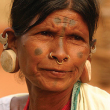 Saora One of the oldest known tribes of India, the Saora, distinct from other tribes do not live in clans but in extended families descended from a common ancestor. The Saora family is polygamous and the total household economy revolves around the woman. They practice shifting cultivation and are most adept at terraced cultivation where they grow varieties of cereal and pulses. Saoras are very religious attributing every natural phenomenon to the work of Gods, deities or spirits. These beliefs contribute greatly to strong social cohesion. The walls of their mud houses are decorated with remarkable paintings and traditional designs. Saora One of the oldest known tribes of India, the Saora, distinct from other tribes do not live in clans but in extended families descended from a common ancestor. The Saora family is polygamous and the total household economy revolves around the woman. They practice shifting cultivation and are most adept at terraced cultivation where they grow varieties of cereal and pulses. Saoras are very religious attributing every natural phenomenon to the work of Gods, deities or spirits. These beliefs contribute greatly to strong social cohesion. The walls of their mud houses are decorated with remarkable paintings and traditional designs.
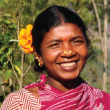 Paroja The Paroja are broadly divided into two sections, one follows the Hindu tradition of not eating beef and buffalo meat, the other does not. Despite these differences the Paroja believe in their common mythological origin, therefore marriage within the same clan is prohibited. Agriculture is the mainstay of the Parojas economy. Traditionally they relied on shift cultivation, however today the Paroja’s depend on wet cultivation supplemented by forest produce, wage earning, and animal husbandry. Paroja The Paroja are broadly divided into two sections, one follows the Hindu tradition of not eating beef and buffalo meat, the other does not. Despite these differences the Paroja believe in their common mythological origin, therefore marriage within the same clan is prohibited. Agriculture is the mainstay of the Parojas economy. Traditionally they relied on shift cultivation, however today the Paroja’s depend on wet cultivation supplemented by forest produce, wage earning, and animal husbandry.
Grass Routes | Orissa Tour | Tribal Tour | Puri | Responsible Travel | Sustainable Travel |



